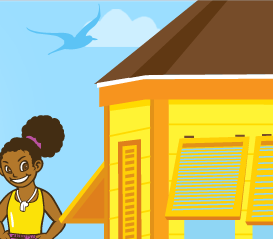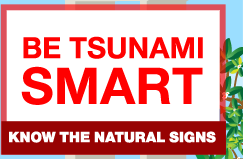Liana: Hi there! My name is Liana and I’m the junior lifeguard at this beautiful beach. And this is Tommy, my pet turtle.
He’s really smart. He helps me alot when I talk to kids like you about how you can be Tsunami Smart.
Tommy: That’s right Liana. The beach can be fun but we have to be Tsunami Smart. Anybody who is in the path of a tsunami is in great danger. In order to survive a tsunami, you must be prepared. If your home or school is near the sea, you need to know how to spot the signs of a tsunami. We can help you.
Liana: Well said Tommy. You can be Tsunami Smart by being prepared for a tsunami. Tsunami Smart Kids make sure that they know what to do before, during and after a tsunami.
A tSUNAMI (pronounced soo-nahm-ee) is a made up of two Japanese words; “tsu” meaning harbour and “nami”
meaning wave.
A tsunami is a set of huge waves that are caused by something happening under the sea that disturbs the water, such as an earthquake or an underwater volcano erupting.
The waves travel in all directions much like the ripples that happen after you have thrown a rock into a pond of water. The waves can travel as fast as a jet plane and grow bigger as they get to the shore. This means that they can start off as just a ripple of water in the middle of the ocean and become bigger and bigger until they become as high as a very tall building when they hit the land.
Tsunamis are not "tidal waves". This is a mistake many people make. Tsunamis have nothing to do with tides
Capable of inundating (flooding) hundreds of metres inland past the typical high-water level, the fast-moving water associated with the incoming tsunami can crush homes and other coastal structures. Tsunamis can sweep boats onto shore. Obviously, they can drown people and animals, too. Tsunamis can strip beaches of sand that may have taken years to accumulate and undermine trees and other
coastal vegetation.
Most tsunamis are caused by an earthquake that happens somewhere out in the ocean. Earthquakes that happen close to the shore may also lead to a tsunami.
Sometimes, a volcano that is under the sea can erupt and create a tsunami.
A tsunami can also happen when a large rock falls into the sea from a cliff or even when a large rock from the sky (known as a meteorite) falls into the ocean.
Run Away from the Beach
If you feel, see or hear any of the natural warning signs, you must run away from the beach immediately and get to a high, safe place.
Tell an Adult and Ask for Help
If there is an adult with you, tell them that you think a tsunami is coming and ask them to help you to run away from the beach and to a high, safe place.
Find a High, Safe Place
Go up a hill or to a higher area of your town or city.
If you cannot make it to a hill or to a higher area, find a high and strong building and climb to the top of it. You may even have to sit on its roof.
Listen to the Authorities
Sometimes you may also get warnings from your local emergency services. Listen to what they have to say and follow their advice.
Check for Younger Children
Help your younger sisters and brothers, as well as, other younger children to reach a high, safe place. Even if they are not younger, you can still help them.
Leave your Things
Your life is more important than toys, books, school supplies, and other things. Leave them behind and run to a high, safe place such as a nearby hill or the top of a tall, strong building.
Keep Away from the Beach
If you are away from the beach, do not go anywhere near the beach or into buildings near the beach.
Climb a Tree, But Only if You Have To
If you have no other choice, climb a very strong and tall tree as high as you can.
Grab Onto Something that Floats
If you get caught in the water, grab onto anything that floats, such as a tree trunk, a piece of a building that is floating. Use the floating object to get you near something that will allow you to climb up out of the water, if possible.
Stay Away for Several Hours
Always remember that a tsunami is a set of waves and not a single wave! There may be many, many waves lasting for hours and the next wave may be even bigger than the one before it. The danger may not be over when you think
that it is.
Wait for the “All Clear” Message from the Authorities
Do not return to the area until you get an "all clear" message from your local emergency services. If somebody has a radio where you are sheltering, listen to it for updates. If you do not get the “all clear” message, wait patiently.
A local tsunami is the result of an earthquake, or other water displacing event. It occurs close to a coast line so that residents only have a few minutes to act.
A tele-tsunami is one that occurs outside of the region and its travel time is several hours
before it reaches the Caribbean.
A regional tsunami is capable of destruction in a particular geographic region, generally within
about 1,000 km of its source.











